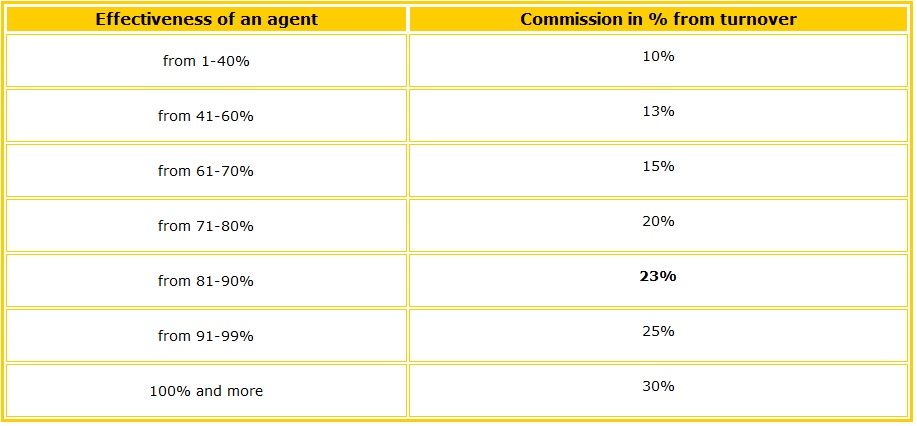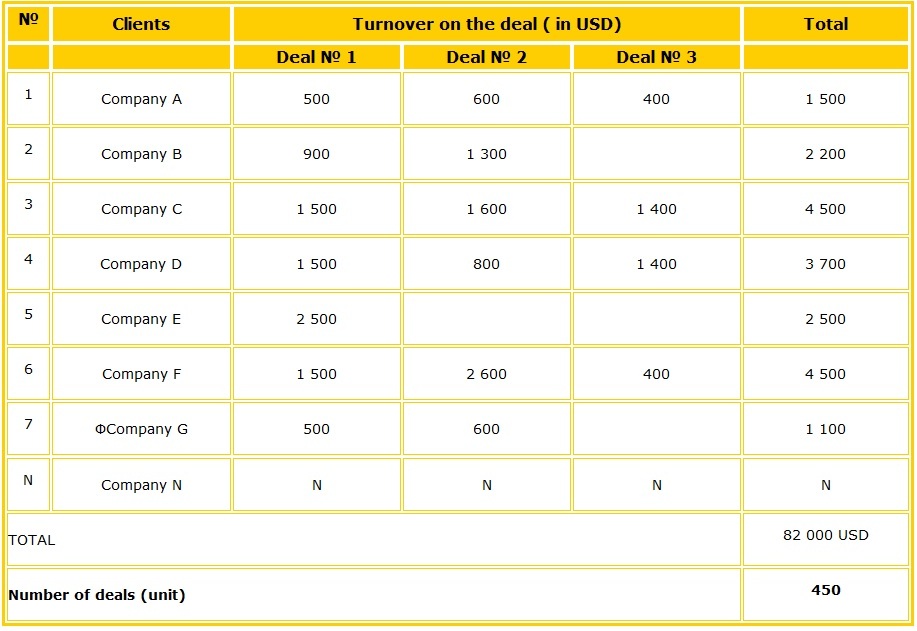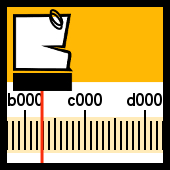THE ARTICLE ABOUT SALARY
The article about salary
SOLVING DIFFICULT TASKS IN THE FIELD OF SALARY
True story 1
The ambiance in two shops of the same company which trade in construction materials differ noticeably. In the shop selling carpets an atmosphere of benevolence reigns but in the shop selling wallpapers salespeople almost hate Clients... In both cases, the system of remuneration is the same: it’s a percentage of the gross revenue (the money received from the sales of products), BUT the problem is that considering the same laboriousness of sales (showing, persuading, registering), the gross revenue in the carpet shop is higher…
True story 2
A shop trades in electrical appliances and housewares. When the sales assistants were stimulated with commissions on gross revenue from products, they actively tended towards Clients who came for major purchases (washing machines, electric ovens, ets), the sales of smaller goods did not cause much interest. When the sales assistants were stimulated with the number of sales, major purchases were abandoned as it is more difficult to sell them (there is much explaining to be done, persuasion and proving), which is not required for the sales of smaller goods.
True story 3
The salespeople of a clothes shop were rewarded with commissions from the gross revenue. The commission was set up in summer. When came autumn and winter, the less expensive summer collection of clothes was replaced by a more expensive winter one (it is obvious that a fur-coat on average is more expensive than a dress), and the percentage of the gross revenue stayed the same. According to the director, the salespeople were receiving undeservedly more money. The Director started to think unkindly of the staff…
The above-mentioned stories from real practice in consulting are combined by one fact: in all these situations the problems linked to salary were not solved, and actually they were not solved in the same way. Note that the task is not at all trivial and, unfortunately, “swept under the rug” by the management.
This kind of avoidance of a really difficult task is quite typical and actually emotionally understandable. The salary is, figuratively speaking, “the gene of the company” after studying of it a lot can be said about the health of the corporative organism as a whole.
The experience of the “TRIZ-CHANCE” system specialists prove th at: regardless of the formulation of the original task, almost no consulting passes without expertize and/or the elaboration of models of salary for the employees.
Herewith, despite the diversity professions, and furthermore, independently on this diversity and also almost independently on a size of any organization, most of the companies are unhappy not “in their own way” but similarly or almost similarly. Hence, a Drosophila fly may have the same mutations as an elephant.
A typical example: as a result of a survey, conducted in the target audience of our site, it was found that only every 10th visitor can actually name one or another successful salary model of the head of the advertising department.
The above-mentioned community allowed us to create a single technology to develop different remuneration systems which would help the user (for example, a head of a company or a department) independent on a branch, a size and a form of activities, and also in the absence of the author, develop models of salary, which allow us to:
- Stimulate the employees to work more productively and effectively;
- Carry out a "natural selection" of more hard-working and able (alas, in most companies is already implemented an “unnatural- selection” of employees);
- Provide feedback to all departments of the company. On the slightest failure in the system, some employee (or the whole department of the company) should certainly feel that it will negatively affect his salary and demand for the situation to be redeemed.
On first sight, the development of the corresponding single technology may seem impossible. Actually, nowadays there are about 50 000 specialties. In addition, apart from that, specialties wearing the same names often have different tasks. Let’s say, for the same position name, a driver who is a chauffeur of a company's director, a driver who participates in races and a “truck driver” should obviously be stimulated differently.
But let’s repeat: after many years of work, it got clear that most of the problems repeat chronically.
Maybe, readers will feel that over this article is hovering the spirit of Taylor F.W. and that of Emerson G. Just like Sir Isaac Newton, in order to see further, we also try to climb on the shoulders of giants.
Hence, a commission for productivity introduced by Taylor F.W. in 1911, is present in every solution. (However the ways to implement it in the examples given below, the readers will probably agree, are not quite clear.) On the one hand, 90 years after Taylor F.W. thousands and thousands of specialties have appeared, which are difficult to normalize. ( It is obviously easier to measure the productivity of a stone cutter or a loader than the labour capacity of a salesperson in a self-service shop or the manager of the advertising department.) On the other hand there have been almost no instrumental material in specialized literature over the same 90 years, devoted to the way of developing various salaries which would not lead to the emotional but unproductive schema: " fair / unfair ".
The relevance of such articles are actually quite large.
THE BACKSIDE OF UNPROFITABLE HABITS
Let’s try to understand what happens in the carpet and wallpaper shops in (Story 1), and find a solution to the problem.
A good idea does not come to mind at once. Unfortunately, the first idea which is unmercifully put into practice in actual life in such a situation is to set up different commissions. The salespeople of the wallpaper shop were given a bigger percentage from gross revenue (turnover) than the salespeople of the carpets shop. As a result: now not only the sellers of the wallpaper shop but also those of the carpet shop are offended…
Which stereotype has prevented the respected manager from getting to another solution? The emotionally understandable but unllogical habit of looking for the only true “the end result” and the desire to pay a commission from the profits or turnover even to those employees whose functions are necessary but not enough for their increase.
The wrongly chosen way immediately drags a stream of new questions: how many percentages of this ill-fated end result to pay to each employee? What is this “end result"? Turnover? Profit? Number of sales? Or, maybe the number of Clients? How to share this goddam commission between salespeople, loaders and expeditors? And how to define a modest contribution of the storekeeper?
If we forget the stereotypes about “end results” and dwell upon the problem from afar, then it is not difficult to see that it is based on the following controversy: the turnover s of the shops are objectively different and the stimulation system should be similar. Since the carpet shop leads in turnover, then it means that its revenue and proportionally to it, the salary should be target for the wallpaper shop. And let’s note that the target is not reachable by the salespeople. Thus even the performance of a super digger cannot be compared to that of an average excavator. Obviously the wallpaper shop needs another target which is not connected to that of the wallpaper shop.
It was proposed to set up a target for each shop immediately on the base of two parameters: the target on turnover and the target on the number of sales. The carpet shop has a higher turnover but the wallpaper shop has a higher number of sales: each one has to work in accordance to its target. As we can see, the end result can have two heads.
Now when we have two targets, we can compare them with the following factors: what percentage meets the normative. This ratio follows Emerson and we shall count it as the result.
Efficiency - the ratio of actual output to the target-standard, multiplied by 100%.

We shall give AN EXAMPLE OF THE CALCULATION:
The results of sales from the carpets shop (for one month):
TABLE 1

The result of sales of the wallpaper shop (for one month):
TABLE 2

Notes
- The numbers in the tables are conditional.
- General efficiency, in this case is calculated as the product of efficiency on turnover and the efficiency on number of sales (for example for the carpets shop 0,88 X 1,03 = 0,91 or 91%).
Now let’s directly move on to the development of salary. It will consist of two parts:
a) the so called "basic" – permanent part which is fixed for each salesperson (it can differ in relevance to knowledge, know-how, experience and other achievements) and
b) "commission" - variable.
"But this already common knowledge. Salary + Bonus", - shall say the reader and be mistaken. The resemblance is only superficial. We shall show you the difference. There will be 3.
DIFFERENCE 1
The Total salary is calculated using the formula:
| Total salary = Basic salary + Basic part х General efficiency |
and not according to the formula: standard salary + bonus on turnover (or profit etc.)".
DIFFERENCE 2
The amount of the basic part is set in the following way, in order for the total salary (that is the salary together with the bonus), for a general efficiency of ~70%, to correspond to the average market value. In such a way, the employee starts to receive a factual bonus (salary which exceeds the average market value) only for an efficiency of more than 70%. We shall come back to this principle further below.
DIFFERENCE 3
The commission part is calculated using the formula:
| Commission part = Basic part х General efficiency |
This implies that the base for calculating bonus has the same name (basic) part of the salary of the employee (ad not the profit, turnover, number of sales etc.).
In other words: the sought-for "end result" considers sales and turnover but the bonus is calculated as a part of the salary. (It’s just that the size of the “part” depends on the efficiency.)
Such an approach removes the necessity to solve some difficult tasks. For example, it is already not necessary to calculate the contribution of the employee in “general chores" in view of "fairly" sharing bonus (from profit, gross value etc.). And what is not least important, this approach does not provoke the employee to ideas about “fairness” diverting him from work.
In our case:
TABLE 3

Now the shops are friendly families.
A GAME IN COMPELLING CIRCUMSTANCES
Story 2 was about the sales of big and small goods. An astute Reader, most probably, noted a distinct resemblance to the situation on first glance.
In the first story, it was all about two shops. The second one is about only one shop. That is the only difference. In both the first and the second situation, we have goods with “different sizes" and the same “jactation” while searching the truth between turnover and the number of sales. It is a typical stereotype which distracts from finding a solution: "either-or". But as we saw earlier, the seeming contradiction goes away when we move to the “either-or” model. That is, not the choice between turnover and number of sales (each position on its own is not enough to solve a problem), but the combination (synthesis) of both into a common principle called efficiency.
The problem described in Story 2, can be eloquently solved in the same way as described in story 1, by setting up two target- standards: on turnover and on number of sales.
However we shall expand the zone of possible solutions.
It is obvious that the director of the shop will demand the simultaneous stimulation of sales of big and small goods. In order to attain this goal, salespeople are often forced to repeat some specific "speech modules", they are fined, they are resented for not understanding…
Unmotivated salespeople naturally “forget”, “feel shy” to take action, become lazy or openly refuse to show additional activity in a “boring work” in accordance to these demands. It is quite difficult to control that. That is how wallpaper is sold without glue, paint without paint-brushes, lamps without additional bulbs.
In order to interest the salespeople in the process of sales, all the goods are transferred from the “storage program” to cards, which remind us of the familiar game from our childhood, cards of “LOTTO”. After the sales of any goods, the corresponding cell on the card is barred. A bonus is paid for a closed line. The more closed lines, the more the bonus.
On each line, the goods are grouped in the following way:
- In each line there should necessarily be one or two big products and the rest are small ones.
- The goods in a line should represent a “set”. For example, Video camera, power supply unit, cassettes, special bag and tripod.
Then the salesperson will propose the customer to buy the video camera with the whole set in order to fill in a line. What else to do? The circumstances are compelling. Now it is do or die.
TABLE 4. LOTTO CARD

Just as in the first situation, two commissions are “folded” into one with this method: commission on the number of sales and commission for turnover.
The "LOTTO" can be effectively used for a range of goods of not more than 100 to 200 units. For a wider range of goods it can be used as an additional move to sell a specific group of goods you need to get rid of.
MINIMUM EFFICIENCY
Earlier we said that in order to evaluate the efficiency of fulfilling any function, it is necessary to set up target-standards. But what shall we do if they are repeatedly not fulfilled?
Let’s consider a distant example. Let’s say, we employed a typist for her to type 1000 pages a month (our target-standard, normative). To simplify, let’s imagine that the basic part of her salary is 400 U.S dollars. If the typist fills her normative (that is, type то есть 1000 pages a month), we shall pay her a 100 % commission for efficiency.
With the formula:
| Total salary = Basic part + Basic part х general efficiency |
where

Hence, if the typist, types out 1000 pages a month:
The efficiency = 1000 pages/1000 pages = 1 or 100%
The total salary = USD 400 + USD 400 х 1 = USD 800
But will the Reader believe the following situation? In a month the typist types out only 30 pages and asks for a commission of 3%:
The general efficiency = 30 pages/1000 pages = 0,03 or 3%.
The total salary = USD 400 + USD 400 х 0,03 = USD 412
"Absurd!" – will say the Reader and he will be right. But the absurd was obvious only after the situation occurred. What if the typists hands out 500 pages and asks for a 600 USD for the work? It is also absurd. The obvious summary: "She did not fill the normative! Why should she be additionally paid?" The formula only is not enough, there should be limit conditions. But before setting them, let’s see another distant example.
A new manager is employed in the department of sales. Let’s suppose that he is set with a target-standard of 10 deals in a month. The basic part of his salary is set to 700 US dollars. The manager repeatedly concludes not more than 5-6 deals a month.
Then:
The efficiency = 5 deals/10 deals = 0,5 or 50%.
His total salary = USD 700 + USD 700 х 0,5 = USD 1050.
It is stunning but a reality that in many companies, the manager concludes only 5 deals and receives his USD 1050.
Of course if he will conclude abnormally few deals (for example, one when all the others conclude from 7 to 10), it will be immediately visible. But in a real business, the main problem often starts with employees who work at a rate of 30-60% of the possible rate. Yes and shouldn’t a rate of "30-60%" itself be absurd?
That is why we insert limits. While solving the task with the two shops, we have already showed that the employee should receive an actual commission (the salary which exceeds the average market revenue) only for an efficiency exceeding 70%. Otherwise the salary of the employee should be limited to the basic part.
In comparison. For a basic part of USD 400, the salary of a typist working at an efficiency rate of 69%, shall be USD 280 less than a typist working at an efficiency rate of 70%, who receives a salary of 400 + 400 х 0,7 = USD 680.
In this case, if an employee repeatedly fails to reach the target efficiency (for example 60-70%), it is recommended to specify: are the target-standards too high? If not, then the employee should better be unmercifully… fired. Yes, this is not in favor of the employee. But this article itself is about the interests of the company and in favor of idlers.
THE POOR GET POORER, THE RICH GET RICHER
Sometimes they say that: "It is good to set up a minimum efficiency where the employee has a permanent and variable part of salary. What if there is no permanent part at all? For example when we talk about agents? After all, actually the agent “sits on percentages” and “does not ask for a part”, no matter how he works. Does the director have moral rights to “pressure” him?"
Let’s think.
TASK
Once the director of a company trading in expensive products, decided to attract the best trading agents of the city. To achieve this goal, he increased the percentage of agent commission in comparison to the other competing companies twice: from 15% to 30% (the benefit margin allowed him to do so).
We propose the Readers to momentarily put aside this article and try to visualize the possible outcome in their mind. And it did not turn out at all rosy. That is, a lot of agents actually gathered of course. However the director did not consider the fact that a high percentage attracts everyone. Not only the best but also the worst and average and all... And since there is always much less really good employees, than the rest, the choice was “hopelessly bad".
"Nothing strange in that. They do not ask for a salary. If there is a deal, there is a commission %, no deal – no commission %", - thought the Director and thus made ta second mistake.
The mistake is as follows. Even if the agents do not ask for a salary, but do a small amount of deals and thus receive a percentage and at the same time holds the office, telephone, photocopy, distracts the management team and other employees, making an “atmosphere of relaxation". Thus, any entrepreneur knows that although paid-for illiquid goods stay safe, it is just equal to pillage. It is more profitable when they are not there.
The right decision (which was actually proposed to the Director) was the introduction of a progressive scale of salary for efficiency (almost like that of Taylor F.W), specified by a corresponding target-standard.
In order to avoid the “gathering” of negligent agents in the company, the commission of agents was differentiated: if the agent is not productive, the percentage he receives falls and he is not interested to work in this company anymore (since in a competitor’s company or such a low productivity he would receive a bigger percentage: 15% instead of 10%).
AN EXAMPLE OF THE CALCULATION OF THE SALARY OF AGENTS
TABLE 5

TABLE 6

Note. This numbers are conditional.
In our example, the agent worked with a effectiveness of 84%, which falls in the range of commission of - 23% from turnover. The actual turnover on the deals concluded by the agent were USD 1100. Accordingly, his commission = USD 1100 х 0,23 = USD 253.
THE AVERAGE TEMPERATURE AT THE HOSPITAL
When setting up target-standards, it is important not to engage in their "pernicious averaging." We shall explain this with an example.
EXAMPLE
A growing retailer company delivers building materials to different groups of Clients:
1) small shops that regularly buy small consignments and
2) major construction organizations that make a single, but very large orders.
In theory, in order to separate two technology services, managers of wholesale, should be divided into two categories:
- Those working with "small but usual” clients and
- Those working with "large and rare" ones.
It is understandable. The process of rendering services to VIP clients strongly differs from the service rendering to the common flow, just like, an expensive restaurant of Japanese cuisine differs from McDonald’s. With the second group of Clients we can meet often and for a long time, make unique contracts etc., with the first one – we need specifically developed flow technology and principally quickly service them. The overlapping of different groups threatens us with low productivity.
However “historically” managers worked with different Clients. Or it was considered that Clients should be serviced by “the one who found him”. What should be done? Preventing the managers from working with one or the other group of Clients is not possible. It would be good if they could “exchange” Clients, but why would they want to do that?
It was proposed to use the principle of "80:20" . During the evaluation of a manager with Clients of the first group, emphasis is put on an increase in “the number of deals” (that is, the number of Clients and the number of deals with each Client), and while working with the second group, emphasis is made on “turnover”.
Note. What is to be considered as a big deal or a small one is quite subjective).
More specifically, it was considered that with managers working with Clients of the first group, the effectiveness depends 80% on the number of deals and 20% on the turnover of the deals:
| Effectiveness common = Effectiveness on turnover х 20% + Effectiveness on the number of deals х 80% |
we use the above-mentioned principle of 80:20)
And managers working with Clients of the second group, effectiveness on the contrary depends 80% on turnover and 20% on the number of deals:

For each category of managers we set up a target-standard:
FOR EXAMPLE
for managers working with the Clients of the first group:
TABLE 7

To calculate the actual index, we make a table, in which are listed the companies of the Clients, in the columns we note the deal and in the cells, the sum of each deal.
TABLE 8

We calculate the number of filled cells in the table. For example there are 450 such cells. This is actually the number od deals concluded by the manager. The sum in all these deals (82 000 USD) – is the actual turnover on deals.
Now we calculate the effectiveness.
Effectiveness on the number of deals (on all the clients of the manager for a month) = the actual number of deals/ the target-standard number of deals х 100% = 450/510 х 100% = 88%.
Effectiveness on turnover = 82 000/100 000 х 100% = 82%.
The general efficiency = Efficiency on turnover х 20% + Efficiency on number of deals х 80% = 82% х 20% + 88% х 80% = 87%.
Now let us count the total salary:
| Total salary = Basic part + basic part х general efficiency |
For a basic part of USD 700: The total salary = USD 700 + USD 700 х 87% = USD 1 309.
Just like in the precedent examples, it is necessary to set up a minimum efficiency level.
Which effect did we attain with this solution? Now the manager can choose himself which system to use to get his salary. If he attains at least the minimum efficiency level for big or small goods, he can receive two basic parts and two commissions.
But this way or another, it is not profitable for him anymore to mix Clients and disperse, it is much better to give away a bulk one and take many small ones instead; or the contrary. Thus, it is clear that one big Client will affect the salary of managers of the first group, on average, 4 times less (80:20) than many small ones.
What happens next?
IS THE MANAGER EQUAL IN POVERTY?
The experience in implementing different systems of salary has shown that one of the external manifestations of “righteousness” of the implemented model is the stratification between “poor” and “rich”.
Some employees start to show activity when they understand the possibility to earn and some criticize the new system show high spiritualism but low-tech talk about the imperfections of the world as a whole and especially in the company… The latter tend to make proposals on the need to redistribute Clients by "fairness" because some employees "are similar to the bourgeoisie" and others have "nothing to feed their families".
No matter how hard is the manager should not give in to such a provocation. In this context it is important for the poor to grow poorer and the rich to stay rich. Because we all know to what cannibalization and collectivization have led. Everyone became poor!
And also, it is not correct, indecent and unproductive for a manager to spend the same amount of energy and time on idlers and successful employees.
SUMMARY
Thus let’s list a few typical mistakes related to conceptions and stereotypes which convert salary into “angrary”:
MISTAKE 1
The use of profit or the company’s turnover as a base for commission, though they are the “most understood” they do not always have the suitable criteria for “end result”.
MISTAKE 2
the choice between two false alternatives: pay either from one or from the other parameter (for example either from turnover or from the number of sales). Not one of these alternatives can give a suitable solution. As we saw earlier it can be achieved with “and-and” but not with “either-or”.
MISTAKE 3
the absence of target-standards, understandable to the staff (or as advertisers say, positioned" ones). It is often not understood what is good and what is bad, also what is to be encouraged and what is not to be.
MISTAKE 4
the consideration after set up of target-standards as a triumph of justice (which is actually not possible to attain) and not as permanent treaty process.
MISTAKE 5
averaging the salaries of managers with the same function, but different types of customers. As a result of this mix of service technology, it becomes almost impossible to establish a benchmark (target-standard).
MISTAKE 6
the distribution of commission among employees without a single and understandable system to evaluate the efficiency of their work, and this leads to many conflicts and “wrongs”.
MISTAKE 7
trying to avoid the “stratification” of employees into the “rich” and the “poor”. It should be remembered that it is impossible to set up a communism even in “an individual company”.
THE EPILOGUE OF THE CONSULTANT
From the one side, after concluding a few dozens of orders for the development of salary systems, it is easy to say which system of salary has been used here and how effective it is by just entering any company from the behavior of the employees…
On the other side, after analyzing the “salary problems” facing the management of the company, we can diagnose how efficiently the analyzed business is working in general. It is logical that an elaborate system of remuneration is an important factor in an intensifying competition.
The Author thanks S. Sychev, I. Vikentiev, O. Deinega, the ”TRIZ-CHANCE” system, for their help in writing this article.
Please read the following resources;
- The salary of the advertising department: can efficiency be measured?
- solving "salary problems" in cases of hard competition between different marks and departments in one company
- The stimulation of employees who are not subordinates.














